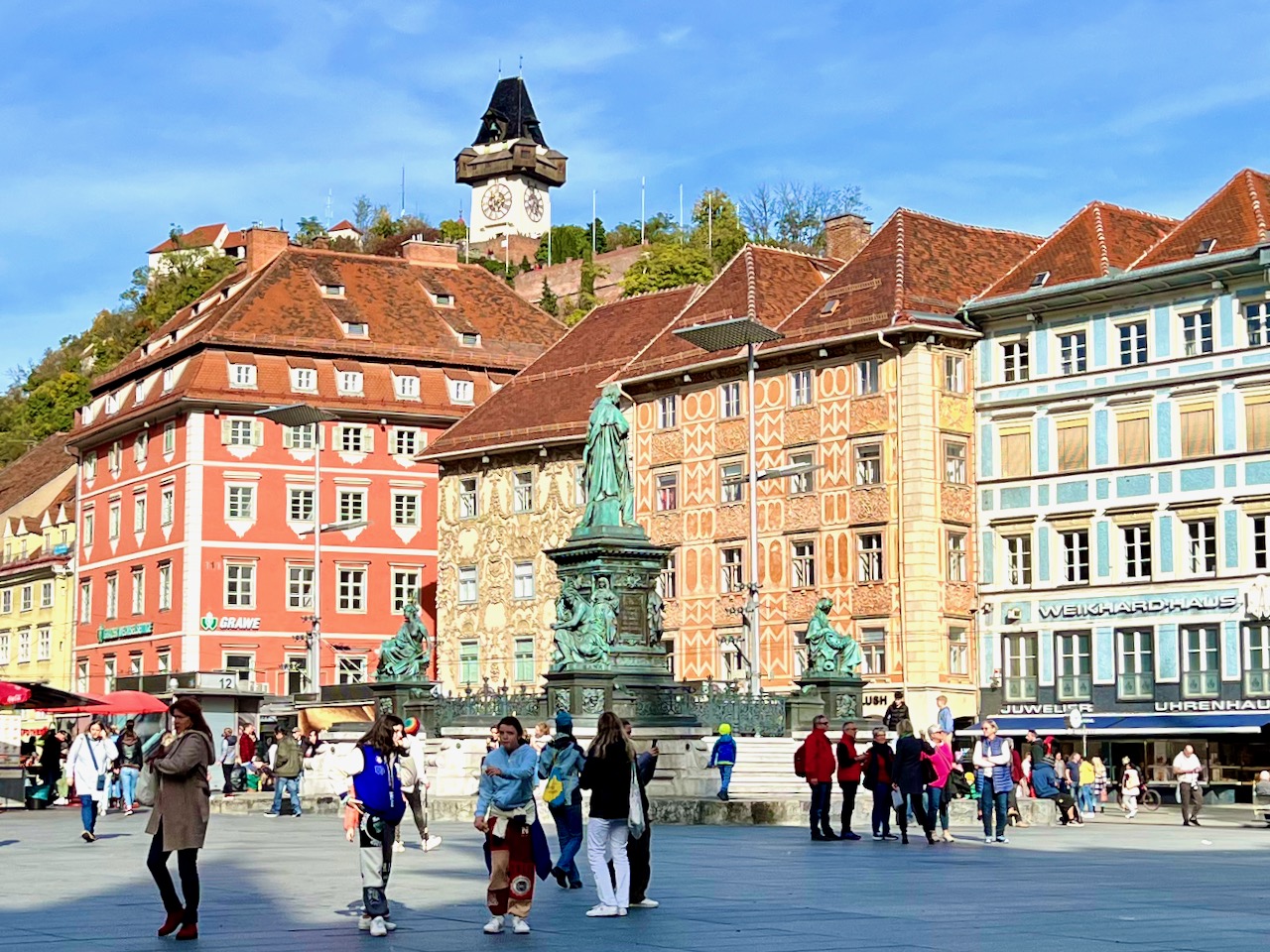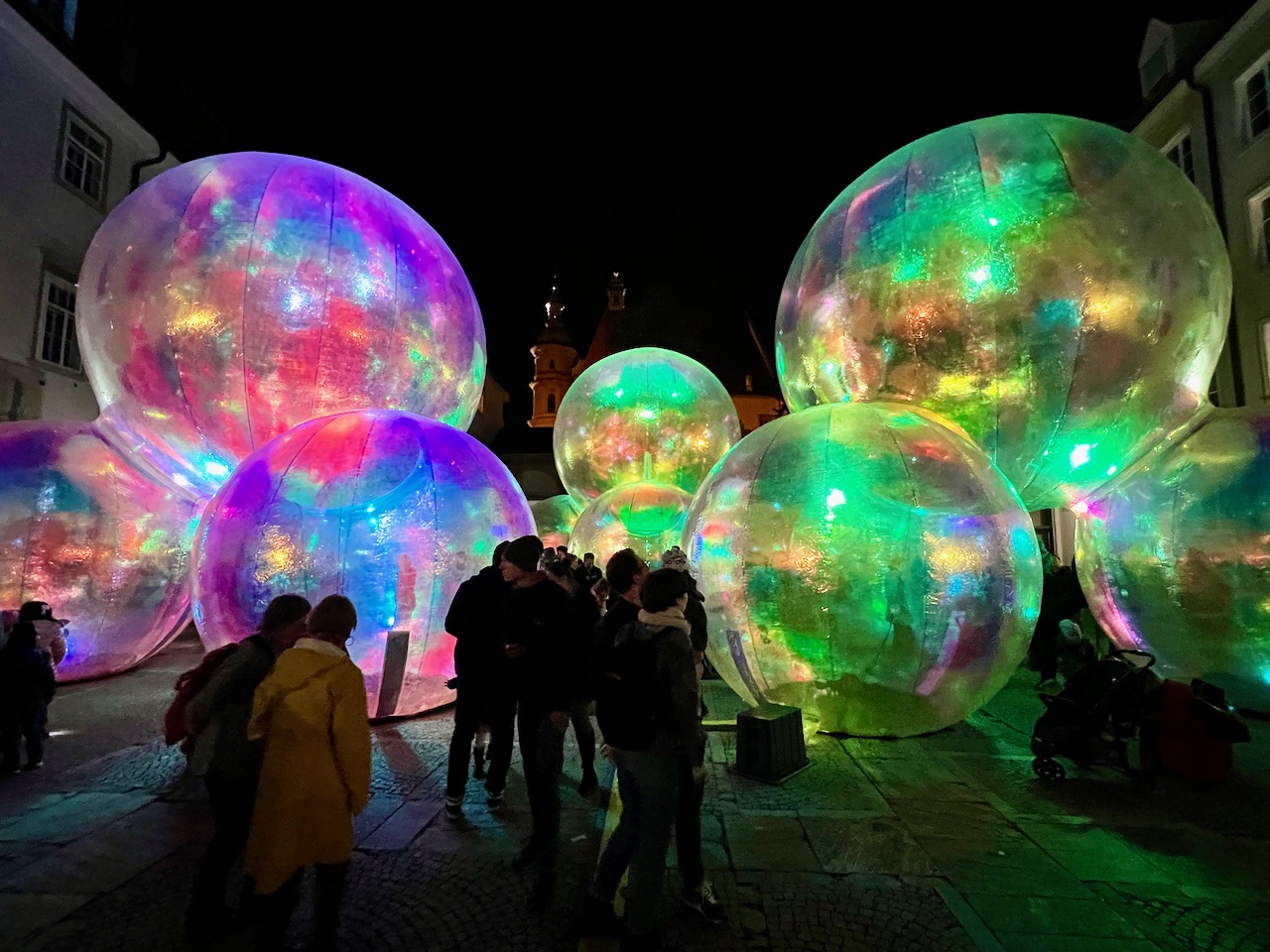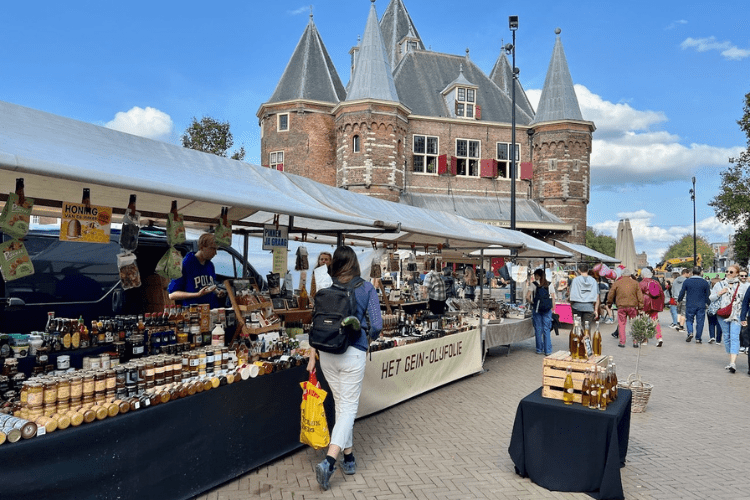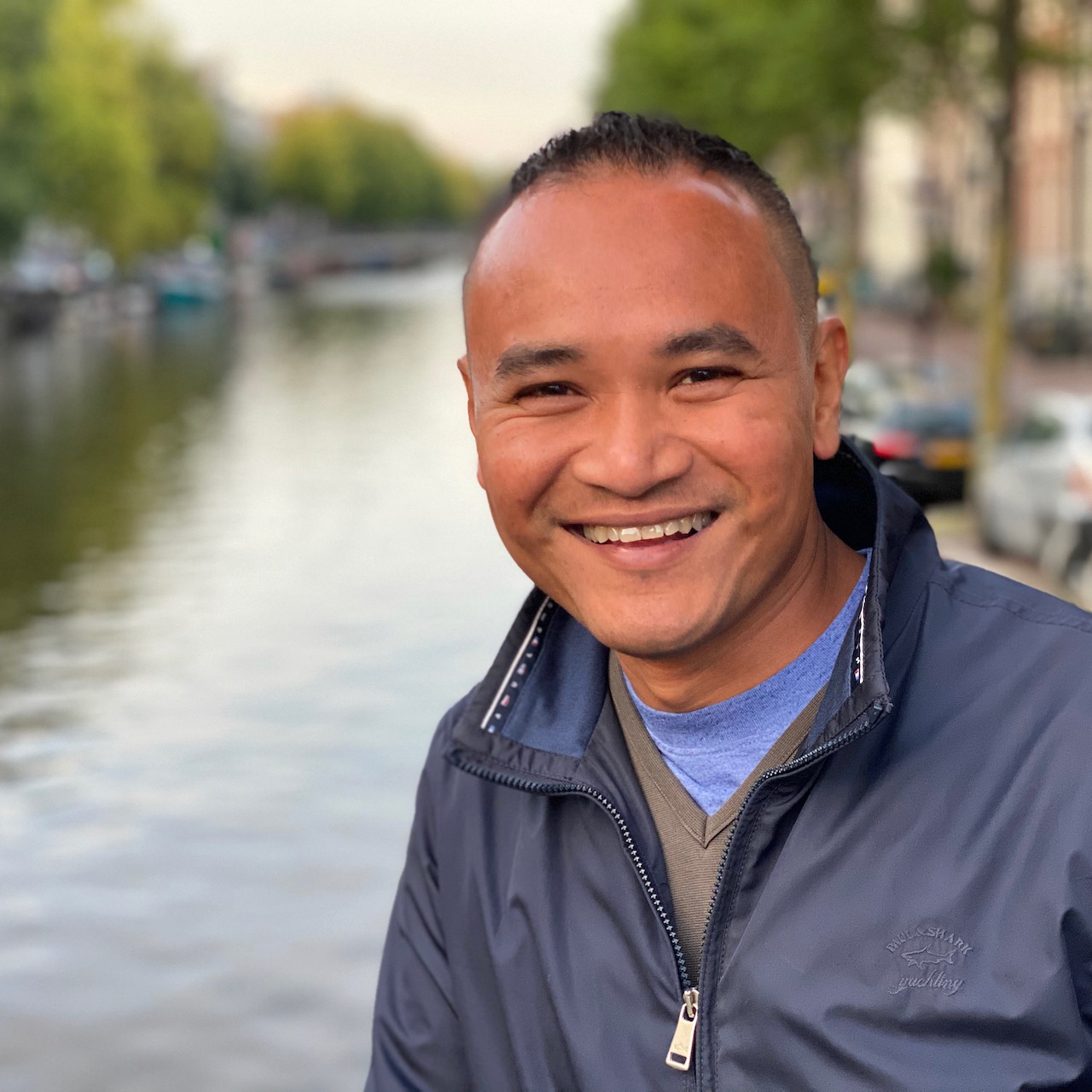This article is written in a collaborative partnership between Rooted and Sustainable Cities.
Co-authored by JoAnna Haugen, Keith Jenkins, and Shivya Nath
Each of us has our own story of finding that blissful moment of holiday happiness: For JoAnna, it was a friendly exchange at a street market in Basel, Switzerland, where she found her favorite secondhand t-shirt that came complete with a story. For Keith, those moments are often found in local markets; admiring, smelling, and sometimes tasting the fresh produce never fails to put a smile on his face, especially as he enjoys chatting with the vendors to learn about the origins of the products and how they're used in the local cuisine. For Shivya, it was the joy of getting to know Copenhagen on two wheels, pedaling from cherry blossom-filled parks to hipster cafes and lakes glowing under the sunset skies.
Happiness might look different for each person, but it has some striking characteristics, regardless of who you are or where you’re from. Happiness manifests itself when people are able to focus on and feel satisfied in the present moment, safe, secure, and connected with others. It’s found when people feel appreciative of their surroundings, and they’re able to maximize time in spaces that elicit joy, awe, wonder, and curiosity.
Being happy doesn’t just feel good: Extensive research has demonstrated the benefits of happiness: It wards off a multitude of health problems, strengthens our immune systems, and lengthens our lives. Feeling happy improves our relationships, increases generosity toward others, and creates the conditions so that we contribute more meaningfully to society. Happier people also tend to be more creative, productive, and optimistic.
What a gift to give people as they travel through cities the world over.
We know what you’re thinking: It is true that, over the last several years, travelers have been actively seeking outdoor, adventure, and nature tourism experiences to find awe, indulge their curiosity, and luxuriate in happy moments. In a rush to find slower, more intentional community-led experiences in rural areas, more people are setting the city-based bucket lists aside.
But urban travel is far from a thing of the past: According to the World Travel and Tourism Council (WTTC), urban tourism is expected to rebound significantly, with several cities far exceeding 2019 visitor spending levels already.
Cities aren’t just tourist hot spots, though. Approximately 54% of the world’s population lived in urban areas in 2015, and this number is expected to increase rapidly, with an estimated 60% of the population living in urban areas by 2030. This interest in cities as both places to visit and live is important to consider, especially when we hold a regenerative lens up to our work in tourism.
After all, a great place to visit must first be a great place to live.
This surge of visitation to and habitation in urban spaces – and the cross-pollination of tourists and residents – is a compelling reason for city planners and destination management organizations (DMOs) to work closely together. It is entirely relevant for tourism stakeholders to be concerned about addressing basic needs like access to food, water, shelter, and safety for residents; without these foundational elements, the environmental conditions for happiness are a moot point.
Once these are secured, however, decision-makers should be thinking about and infusing elements that inspire happiness into city planning and promotion so that both visitors and locals in these tightly shared spaces are able to enjoy and derive positive benefits by being in cities.
And, let’s face it: Even if travelers continue to seek out countryside getaways, chances are they’ll be passing through a city to get there. So, the experience might as well be a good one.

Safe, spacious gathering places like the Hauptplatz in Graz, Austria, encourage social connection, which is tied to happiness. | Photo credit: Keith Jenkins
Centering Happiness Through Urban Tourism
Promote green spaces
Access to green space is significantly correlated with happiness, so if your city has it, promote it! Many destinations highlight “noteworthy” areas to visitors (think NYC’s Central Park, Singapore’s Supertree Grove, and Berlin’s Tempelhofer Park), but there are countless courtyards and paths that never get a shoutout.
Whether they are “noteworthy” or not, inform visitors where they can find parks, tree-lined promenades, and other green spaces throughout the city. If there are safety concerns in these areas, advise travelers of this, but don’t stop there. Advocate for funding so that these spaces are safe and accessible for everyone to access.
Think about the five senses
It’s not uncommon to hear people say that cities “overwhelm the senses” – and not in a good one. Distasteful smells and loud noises don’t create happy moments, so suggest ways for people to have experiences that are pleasant for the five senses. For example, offer walking routes that lead people past bakeries or floral shops, down side streets with music schools instead of trash collection, and through areas with colorful street art. It’s not always about getting people from Point A to Point B as quickly as possible; the journey matters too.
Get active
Physical activity is not only stellar for mental health, but it stimulates endorphins, which leads to feelings of happiness. The DMO solution? Encourage travelers to get moving!
This is an opportunity to promote active experiences like walking tours, 5k fun runs, and interactive museum exhibits. It’s also an incentive for cities around the world to center person-friendly connectivity in urban planning. Streets where people can walk and cycle safely are not only more pleasant to traverse and environmentally friendly, they may also boost a city’s happiness quotient – for both residents and travelers.
Suggest places to play
If there’s one thing many adults lose as they age, it’s the ability to play. Our lives simply aren’t built around opportunities for frolicking, laughing, or just letting loose. Yet playing, like physical activity, has been shown to seed happiness. In fact, when kids are involved in city planning, they prioritize play and social connections. Perhaps we could learn from them.
From a tourism standpoint, this offers a couple different opportunities: Make sure families know where they can find kid-friendly spaces like playgrounds and children’s museums. But also inform adults of activities like interactive art exhibits and drop-in art and fitness classes.
Create gathering spaces
Social connection is a key component of happiness, so make sure there are plenty of accessible, safe spaces where anyone and everyone is welcome to gather. These may include experiences like free outdoor performances or open public showings of sporting events or movies.
But this is also an invitation for cities to create car-free zones where people have impromptu encounters with each other while walking their dogs or enjoying a mid-afternoon snack during a busy day of sight-seeing.
Highlight opportunities for connection
Building spaces for spontaneity in cities is important, but also let travelers know of opportunities for intentional social connection. Promote experiences like cooking classes, culinary tastings, and quiz nights. Even gatherings that might seem exclusive for local residents, like park clean-ups, are an excellent way for travelers to interact with a city and meet the people who live there.

Graz's Klanglicht light and sound festival is one of many community festival's in this Austria City, which hosts many community celebrations that bring people together. | Photo credit: Keith Jenkins
Urban Spaces Built for Happiness – For Locals and Travelers
The organic markets of Amsterdam
The smell and taste of fresh organic food is pleasurable for the senses, but knowing that our food has been produced in a way that’s good for the soil and our bodies is believed to elevate our happiness.
Every Saturday, the organic market at Nieuwmarkt draws in locals and conscious travelers for locally grown, natural produce, along with curated delights like mushrooms and bread. The Pure Markt (“Pure Market”), held in a different park every Sunday during the spring/summer months, has a strong focus on organic, sustainable, and/or artisanal products, and comes highly recommended among eco-friendly things to do in Amsterdam. It's always a joy to browse around the various stalls (70% of which is food), join a product tasting, talk to the vendors about their products, or simply enjoy a freshly made sandwich (and a glass of organic wine) on the grass, while listening to a local band playing.
Slow, conscious fashion in Bangkok
Studies have linked the consumption of slow, deliberate fashion to the well-being of both artisans and buyers. In Bangkok, the fast fashion capital of Asia, that means skipping the shiny brands for transparency and traceability. At Folkcharm Studio, the fashion supply chain starts with the organic cotton farms in the Loei Province, features female Thai weavers handweaving clothes, and uses only natural dyes. These slow fashion weaves are made with love, represent empowerment and climate action, and bring happiness to the growers, weavers, and travelers alike.
Community festivals in Graz
In a world where social isolation is becoming the norm, community celebrations are a joyful way to bring people together. In Austria’s second city, autumn is not just a time of soulful outdoor colors, locally-grown organic produce, and wines from the surrounding hills, but also a season of festivals that bring together residents and travelers through community-centric experiences.
In September, the community-founded Grieskam festival invites people to “dance, sing, discuss, listen, eat, laugh, and celebrate together.” In October, the delectable Truffle Festival, and magical Klanglicht light and sound festival, are local favorites. Joining in the fun, buying upcycled designs, listening to resident bands, and tucking in to delicious seasonal food are experiences that make travel so rewarding.
Portland, Oregon, on two wheels
Through its physical and mental health benefits, cycling tends to increase happiness in a far more compelling way than other sports. In Portland, Oregon, one of America’s greenest cities, it is not just a sport but a way of life for locals, and a draw for conscious travelers.
During Pedalpalooza, a summer festival organized by locals, hundreds of themed public bike rides take place across the city – from family-oriented scavenger hunts and Star Trek-themed rides to adult-only pub crawl rides! A great ride to start with is the Kickoff Ride where participants are invited to dress up themselves and their bikes, and take to the streets. One of the most popular rides is the World Naked Bike Ride, which sees thousands of riders cycling through the city in the buff! Pedalpalooza is a unique festival that brings the community (and visitors) together while embracing a green way to travel, explore, and have a fun-filled time.
Mumbai’s informal circular economy
A circular economy that meets everyone’s needs (not greed), and contributes to prosperity for the planet and people, is believed to reduce our collective stress and change our relationship with consumption. The recycling economy of Mumbai’s largest urban slum, Dharavi, is rooted in circularity. Sixty percent of all of Mumbai’s plastic and 80% of the city’s solid waste gets recycled here! Micro entrepreneurship thrives through unorganized markets, featuring embroidery, pottery, faux jewelry, and even traditional food. As travelers seeking a different side of Mumbai, it’s a reminder that circularity and sustainability have been part of local cultures for centuries – and there’s much to be learned from this “poor little rich slum.”
Your Invitation to Embrace City-Styled Happiness
Just like happiness can look different for each person, the pursuit of happiness can look different for each city. Yet there are common threads that tie together what the tourism industry can offer, and what residents and travelers seek. Green and gathering spaces, cycling and walking trails, slow and organic fashion, and urban circularity, when woven together, can create better places to live and therefore better places to visit.





